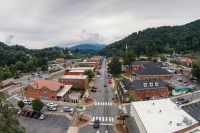The advent of the boulevard, the death of the five-lane
Nearly every town has one — a five-lane road lined with fast-food stores, gas stations and grocery stores — and most sport a few. But those, it turns out, may have been a bit of a mistake.
The N.C. Department of Transportation has kicked five-lane roads to the curb in favor of landscaped medians. Throw in some sidewalks and street trees, and there’s an uncanny resemblance to the boulevard design lobbied for by new urbanists and smart growth advocates over the years — although the DOT’s version is decidedly larger and more utilitarian.
Despite a paradigm shift dating back at least a decade, the design is still being embraced by the mainstream, particularly in the mountains where there are few examples of boulevards.
“Part of that is a trickle down from Raleigh,” said Wade Walker, an engineer and transportation planner with the Charlotte firm Fuss and O’Neill. “The DOT central office has basically admitted it is going to take time for this thinking and philosophy to trickle down into the individual districts. It is like turning around an air craft carrier. You can’t do it overnight.”
When Derrick Lewis started working for the DOT road design unit in 1997, everyone was still designing five-lane roads for nearly every application.
“It was the standard at one time to be five lanes,” Lewis said.
Related Items
By the end of the decade, however, five-lane roads were on the way out.
“It was probably more of a project by project decision at first and at some point it made a swing in the other direction,” Lewis said.
At first, medians cropped up only along part of a road, with a combination of a middle-turn lane and a landscaped middle, much like the Old Asheville Highway in Waynesville; it was designed in the late 1990s when the five-lane design was beginning to fall out of favor.
Now, medians are the standard for commercial roads.
Lewis said he was an early convert to medians.
“I was one of the ones trying to get people trying to think about putting a median in,” Lewis said.
He oversaw feasibility studies for makeovers of N.C. 107 in Sylva and South Main in Waynesville — and both have proposed medians.
The DOT hasn’t necessarily embraced medians for their aesthetics, but for their ability to move more traffic without adding more lanes every couple decades.
Traffic moves faster with a median. Without cars darting in and out of parking lots across lanes of oncoming traffic motorists aren’t as brake-happy.
“You feel like they are about to cut out in front of you,” said Joel Setzer, head of the DOT division for the 10 westernmost counties. “Once you start getting congestion, and you have one person that has to come to a stop to make a turning maneuver, it creates an accordion effect, or slinky effect. That stop leads to congestion all down the stream.”
Businesses are often the opponents to medians, however, fearing they would lose prospective customers cut-off from making left turns into their parking lots. And so the DOT acquiesced by installing that middle-turn lane.
“In the past they just kowtowed too much to adjacent property owners,” Waynesville Town Planner Paul Benson said.
Far from being newfangled, boulevards historically were the design of choice for the flagship artery of a city, moving high volumes of traffic through town, yet flanked by high dollar commercial real estate.
“It is basically reinventing an old idea,” said Scott Curry, an urban designer and planner with the Lawrence Group, one of the state’s most well-known and progressive planning firms based in Davidson. “Boulevards are one piece of rediscovering design that is more oriented toward the pedestrian.”
So where did the DOT go wrong all those years?
“For many years, street designers and transportation engineers have been preoccupied with the volume and speed of cars only,” said Curry. “The car became the singular focus of what people planned and designed for.”
Enter the boulevard.
“When it is done effectively it is a good compromise between accommodating through moving traffic and local traffic and pedestrians,” Curry said.









